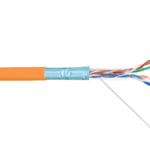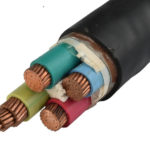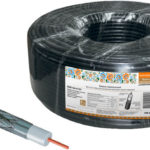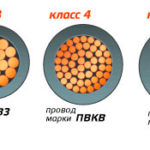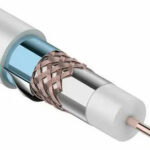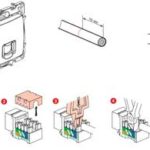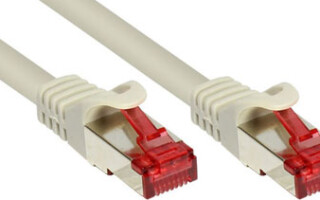When conducting local communication lines, an ethernet cable is used, which is available in several varieties (coaxial, fiber optic, twisted pair). The diameter of the cable, the composition and type of cores, the speed and quality of information transfer differ; products are produced in one piece and twisted, standard or shielded.
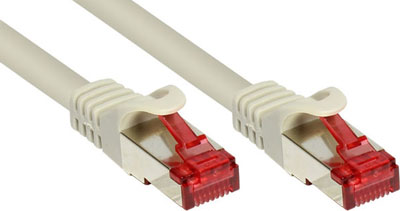
Content
Types of cables for the Internet
In the list of the main types of network cables:
- coaxial;
- fiber optic;
- twisted pair.
The design of the coaxial wire includes a conductor with a dense insulating coating, a copper or aluminum braid, and an outer insulating layer. In addition to connecting to the network, Internet products are used to translate signals from antennas and television satellites to build high-speed digital networks (cable TV).
The configuration of the wire connectors is different:
- The BNC connector clips onto the ends of the cable, providing connection to the T-connector and the barrel connector.
- BNC barrel connector is designed to connect damaged elements or extend the wire to expand the range of the network, connect additional electrical equipment.
- The BNC T-connector is a tee used to connect computer equipment to the main network line. There are 3 connectors in the wire (1 is intended for output to a centralized network, 2 connectors are required for connecting a local system).
- The BNC terminator is designed to act as a ground stop to prevent signal propagation outside the local line. The connector is required for the stable operation of network connections that occupy a large area.
A twisted-pair network cable is used to create local lines. The products include pairwise twisted copper conductors with an insulating layer. The standard wire consists of 4 (8 conductors) or from 2 pairs (4 cores). Between devices connected with a cable, there should be no more than 100 m according to the standards. The wire is available as standard or with protection. To work with the cable, an 8P8C type connector is used.
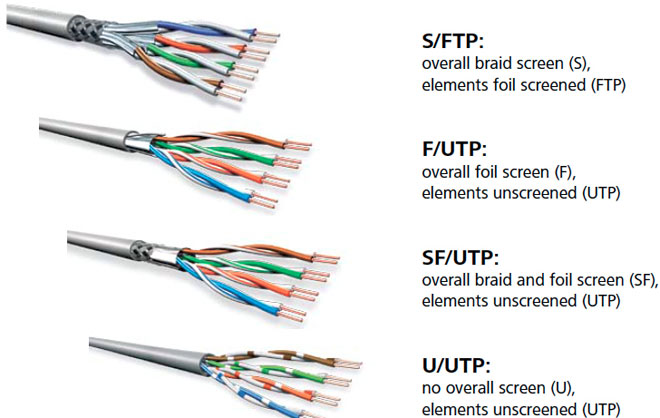
Before choosing a twisted pair cable for the Internet, it is necessary to determine the subspecies according to the characteristics of the outer layer (thickness, presence of reinforcement, composition). UTP wire with a plastic outer layer is not protected, it is produced without grounding. F/UTP, STP, S/FTP products are manufactured with shielding.
Twisted pair cable marking reflects the categories by the color of the insulating layer:
- gray (used in the interior spaces of buildings);
- black (used to designate products with a coating for protection against atmospheric precipitation and electromagnetic radiation, used for street structures);
- an orange tint is used to indicate non-flammable polymeric compounds.
Fiber optic cable is an advanced wire for building network lines. The product consists of plastic fiberglass light guides with plastic protection. Cable products are distinguished by a high speed of information transfer, resistant to interference on the line. Wire can connect systems over long distances. Products are divided into single and multimode.
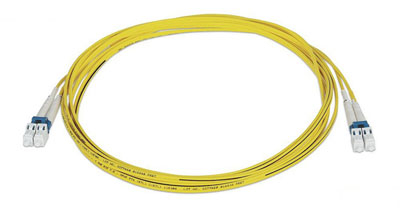
Fiber optics uses different types of connectors (FJ, ST, MU, SC). The wires are budgetary, look aesthetically pleasing, but require the purchase of additional equipment and are difficult to install. Products are used to form large-scale network systems, create access to the Internet at high speed.
Copper conductors in an Ethernet cable are available:
- whole;
- twisted.
Solid conductors are strong, reliable, durable, but less ductile. The products are intended for stationary systems in rooms or laying of short lengths on external structures.
Stranded products consist of thin copper wires twisted together. The cables are durable, flexible, designed for placement in workspaces, in places where objects need to be moved.
What are the veins
In network wires, several variants of cores are used:
- copper;
- copper-plated.
Copperplated
Copper-plated elements are characterized by a low speed of information transfer. The central part is made of composite raw materials, the outer layer consists of copper alloys. The loss of electrical energy in the wire is small, because. current flows through the outer layer.
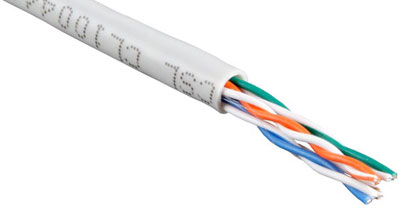
Several types of copper-plated network products are produced, differing in the materials of the central part of the core:
- CCS;
- CCA.
The name CCA refers to products made of aluminum with an outer layer of copper alloys. Products are plastic, high-quality, easy to install.
CCS is copper-plated steel wire. The cable is durable, less elastic than aluminum counterparts, not recommended for long networks, because. when twisting, cracks form in the products. The product does not withstand the crimping process.
Number of cores
The twisted pair cable can be produced with 4 and 8 cores. For transmission according to the standard at speeds up to 100 Mbps, you can use 4 cores, but to get more than 100 Mbps - 1 Gbps, you need all 8 cable cores.
Therefore, it is necessary to find out in advance what the Internet speed is in the apartment in order to choose the correct number of twisted-pair cable cores.
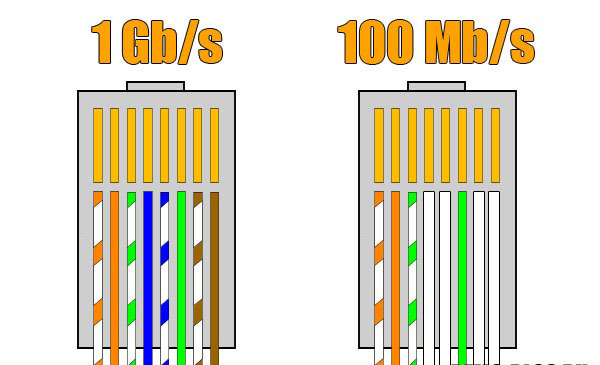
Products are also produced:
- single-core;
- stranded.
Cables with 1 copper core are used for conducting lines in wall panels, for connecting to sockets. It is not allowed to contact a single-wire product with network equipment. On extended lines, the veins can be deformed, destroyed.
Multi-core cables consist of several wires. The view is not intended to be cut into the outlet panel. Products are plastic, recommended for complex wiring with twists, laying in corners and passages. The products are suitable for units that combine devices.
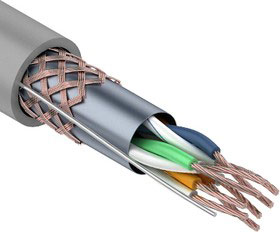
Copper or cable partially copper-plated
When choosing a wire, the length of the network, the number of connected objects are taken into account. At short distances, the difference in products made of copper or copper-plated is insignificant. When conducting networks with a length of more than 50 meters in copper-plated wires, signal transmission failures occur.The conductivity of aluminum alloy and steel is lower than that of copper.
Products made of copper alloys are designed to build large-scale local systems with a distance between objects of up to 10-20 meters. Products do not interfere with signal translation. To connect a computer with tees, sockets, switching equipment, there are enough cores with a combined composition (copper-plated).
The video below clearly shows the difference between a copper FTP core of a twisted cable and a copper-clad aluminum UTP.
Cable categories
In the markings, the cable for the Internet is divided into categories numbered 5-7, reflecting the characteristics of the manufacturing method (twisting pitch, type of separating material, core diameter).
CAT5 contains 4 pairs; transmission characteristics when activating 2 pairs reach 100 Mbps; the conduction band reaches 100 MHz. Products of the fifth category are intended for connecting computer lines.
CAT5e - combines 4 pairs. Connecting 2 pairs allows you to reach 100 Mbps; when using 4 pairs, the speed increases to 1000 Mbps. The technical parameters of the product exceed the characteristics of the CAT5 cable. Networks can be laid to transmit data over long distances.
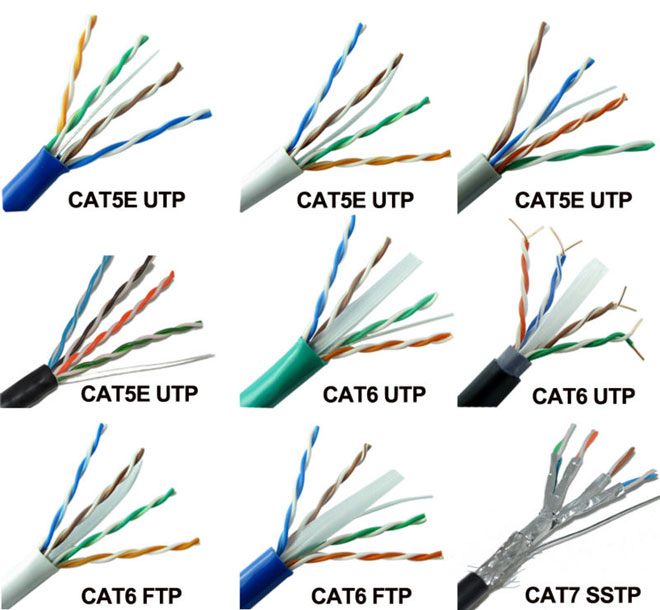
The wires of category CAT6 contain 4 pairs of cores, when connected, the transfer rate of information is 10 Gbps to a territory limited to 50 m. The bandwidth is 250 MHz. Product types are optimal for making complex networked computer connections.
The CAT6a cable category contains 4 pairs. The speed characteristics of the networks are 10 Gbit/s, the length of the lines is 100 m, the bandwidth is 500 MHz.Advanced products are provided with a common shield or protection for each twisted pair. Products are durable, designed for network connections in residential and public buildings.
CAT7 products have 4 pairs of wires. The connection is high-speed, with high-speed broadband Internet (10 Gb / s); the bandwidth is 700 MHz. Category 7 cable is equipped with an external screen and additional protective elements.
Shielding
Cable shielding helps reduce line noise. To make network connections from the wall panel to computer equipment, an unshielded wire is sufficient; shielded cable is necessary when pulling lines in walls, along the outer surfaces of structures, in areas with high noise intensity and electromagnetic radiation.
Shielded network products are represented by brands:
- FTP - stands for products with a foil single screen;
- F2TP - cable products are protected by a screen of 2 layers of foil;
- S/FTP - each core is shielded using foil, for the outer layer a mesh of copper alloys is used;
- STP - cores are protected from foil, external shielding of the wire structure is provided;
- U / STP - the cores are protected with foil, no external insulation is provided;
- SF / UTP - products with double external shielding, copper braid and foil sheets, twisted pair, according to its characteristics, is the most durable and protected from atmospheric precipitation.
For residential premises, cable products with F2TP or FTP shielding are recommended. It is recommended to buy products for conducting networks in public premises with SF / UTP, S / FTP markings.
Similar articles:
